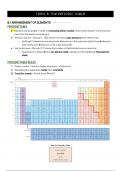Class notes
Chemistry 0620 Topic 8 Notes - The Periodic Table
- Course
- Institution
These topic notes have been made in conjunction with the 0620 Cambridge IGCSE Chemistry syllabus, utilising diagrams and explanations from various study resources. They cover all the syllabus statements for Topic 8 of the syllabus - The Periodic Table. The notes are written in concise bullet points...
[Show more]



